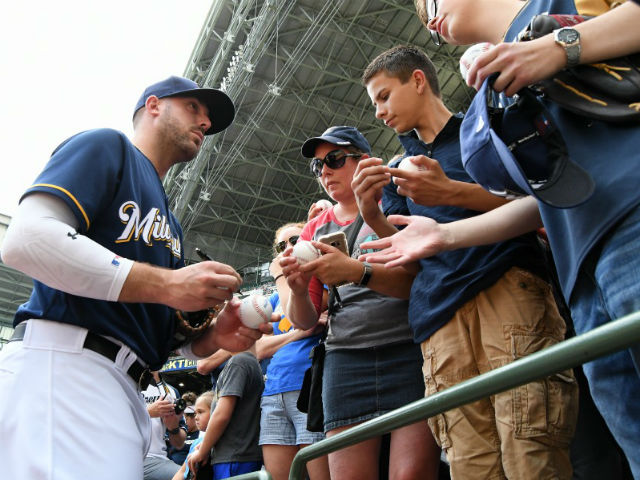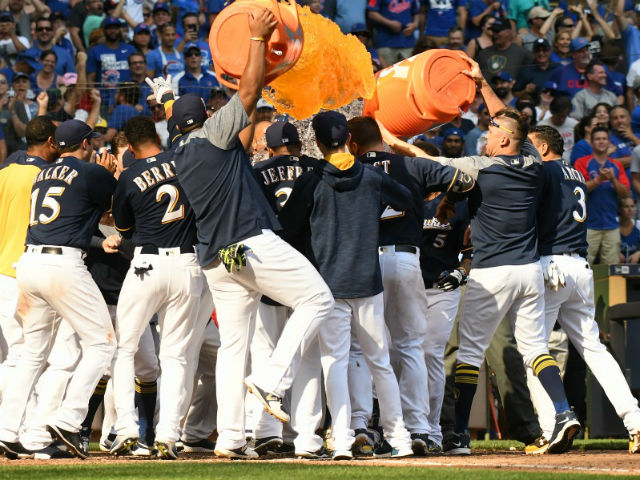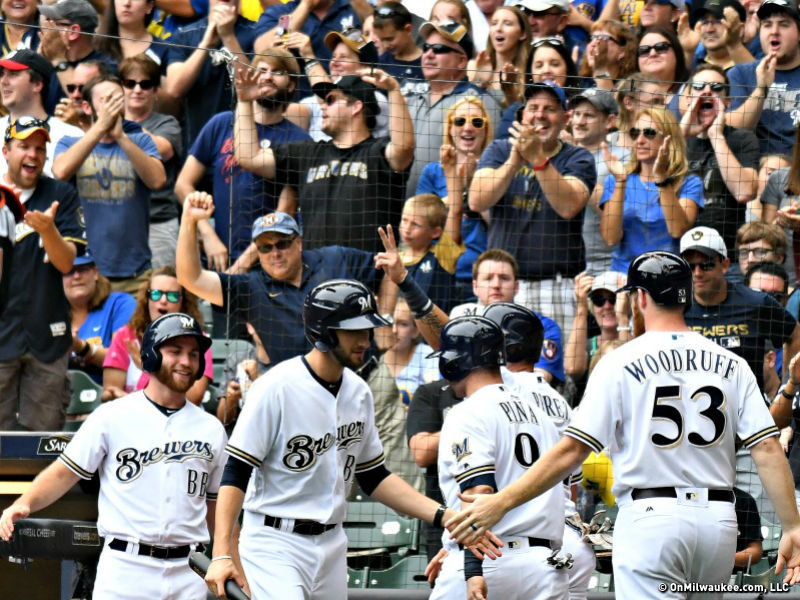With a 4-3 win over the Cincinnati Reds on Thursday that kept their still-flickering playoff hopes alive heading into the season’s final weekend, the Milwaukee Brewers concluded the home portion of their 2017 schedule. And, for the young and rebuilding club whose owner recently admitted had outperformed internal expectations, it was a surprisingly successful year not only on the field, but also in the stands and at the gate.
Having played all of their 81 games at Miller Park, the Brewers rank 10th in Major League Baseball in home attendance, with a total turnout of 2,558,722 and an average draw of 31,589. Many MLB teams still have home games left to be played, though Milwaukee’s position is unlikely to change.
The club currently ranks just ahead of Washington (2,420,749 total attendance; 31,035 average) and Texas (2,412,581 total; 30,930 average). The Nationals cannot make up the 137,973-person difference due to their stadium capacity; the Rangers (146,141 difference) would have to draw 48,714 people – more than 99-percent capacity – for their final three games to move ahead of the Brewers.
Milwaukee finished with an overall attendance above 2.5 million for the 10th time in the last 11 seasons, a truly impressive feat for a team that plays in what is considered MLB’s smallest market. The only year the Brewers fell short of the 2.5 million mark was in 2016, when they were just beginning their full-scale organizational rebuild and trading away veteran players. Many fans and media members believed 2017 would be a similar struggle – in terms of baseball and interest – but the upstart squad played well all season and managed to draw crowds, even if it didn’t always feel like the Brewers had local or national sports attention.

In 2016, Milwaukee had a total home attendance of 2,315,244 and an average of 28,583 per game. This season’s figures amounted to a year-over-year overall difference of 243,478, or 3,006 more people at each game. Miller Park’s capacity is 41,900, so the Brewers for the entire year were at about 75-percent capacity.
"I think this group is able to rise to expectations. They continue to prove that," principal owner Mark Attanasio told reporters over the weekend. "When we started last season, when we had 2.3 million fans come out, you’re getting in on the ground floor. You’re getting to know who these (players) are."
Attanasio added that the Brewers’ extra ticket revenue from fans "helps level the playing field versus teams that have more resources," a testament to the outsized importance of the turnstiles in Milwaukee.
"We’re in a fortunate position so we can maybe ‘punch a little bit above our weight.’ I always felt like we could punch above our weight in this community," he said. "We’re going to draw more than 2.5 million people this year.
"At the same time we’re trying to sneak into the playoffs, I think we’re trying to sneak into the 10th spot in baseball from an attendance standpoint. Every year of our ownership, we’ve had more sponsor dollars come in. That’s very good, but a challenge. So, the support from the fans, either by showing up at the ballpark or sponsors, has always helped us do the incremental extra."

The Brewers’ strong play – they were in first place in the NL Central for most of the first half of the season – and the Chicago Cubs coming off the 2016 World Series championship meant that the two rivals’ typically well-attended games in Milwaukee were even more popular. The Brewers had 11 sellouts this year, with Cubs games – and Chicago’s horde of fans that call Miller Park "Wrigley Field North" – accounting for six of those dates.
Publicly, there’s no one universally accepted calculation for determining market size, that oft-referenced but relatively vague term comprising metropolitan population, resident income, number of cable TV subscribers in a team’s area, local broadcast contracts and more. As of the end of 2016, when the previous MLB collective bargaining agreement expired, Milwaukee was the 30th-ranked market among the 30 teams in baseball.
As the Brewers pushed for the playoffs down the stretch, there were some free-ticket giveaways to try and get more fans in the gates. For an early September series against the Pirates, team partner MillerCoors purchased 15,000 total tickets to be distributed to fans; for the final home game Thursday against the Reds, Brewers players Ryan Braun, Corey Knebel and Hernan Perez bought 2,500 tickets each for fans. And while those offers could be seen as a way to boost dwindling crowds late in the season, Milwaukee’s yearlong attendance figures suggest the organization didn’t need to do it.
As Braun said in a statement: "Our fans are a big part of what we have accomplished this year, and on behalf of Hernan and Corey, we wanted to do something out of the ordinary to show how much we truly appreciate them. We've seen over two and a half million people come through the gates this year, and we want every one of them to know that their voices have been heard. We're fighting hard to extend the fun here through October, and we know that this last home series will be a great environment for players and fans alike."
Going into this weekend's series in St. Louis, the last one of the regular season, Milwaukee is two games behind the Colorado Rockies for the National League's second Wild Card playoff spot. If the Brewers sweep the Cardinals, and the Rockies lose once to the Los Angeles Dodgers, Milwaukee and Colorado will tie and have a one-game playoff. If the Brewers sweep and the Rockies get swept, Milwaukee will be in the postseason.
Born in Milwaukee but a product of Shorewood High School (go ‘Hounds!) and Northwestern University (go ‘Cats!), Jimmy never knew the schoolboy bliss of cheering for a winning football, basketball or baseball team. So he ditched being a fan in order to cover sports professionally - occasionally objectively, always passionately. He's lived in Chicago, New York and Dallas, but now resides again in his beloved Brew City and is an ardent attacker of the notorious Milwaukee Inferiority Complex.
After interning at print publications like Birds and Blooms (official motto: "America's #1 backyard birding and gardening magazine!"), Sports Illustrated (unofficial motto: "Subscribe and save up to 90% off the cover price!") and The Dallas Morning News (a newspaper!), Jimmy worked for web outlets like CBSSports.com, where he was a Packers beat reporter, and FOX Sports Wisconsin, where he managed digital content. He's a proponent and frequent user of em dashes, parenthetical asides, descriptive appositives and, really, anything that makes his sentences longer and more needlessly complex.
Jimmy appreciates references to late '90s Brewers and Bucks players and is the curator of the unofficial John Jaha Hall of Fame. He also enjoys running, biking and soccer, but isn't too annoying about them. He writes about sports - both mainstream and unconventional - and non-sports, including history, music, food, art and even golf (just kidding!), and welcomes reader suggestions for off-the-beaten-path story ideas.







